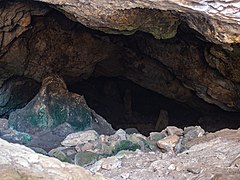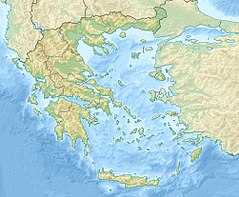Eileithyia Cave
 | |
| Alternative name | Cave of Eileithyia |
|---|---|
| Location | Crete |
| Region | Greece |
| Coordinates | 35°19′29.2″N 25°12′21″E / 35.324778°N 25.20583°E |
| History | |
| Periods | Neolithic, Bronze Age |
Eileithyia Cave (also the Cave of Eileithyia) was a sacred cave dedicated to the goddess of childbirth, Eileithyia, on the island of Crete, that was used from the Neolithic era to the Roman, with worship flourishing in the Late Minoan period.[1] It has been suggested that rock formations within the cave resemble female figures, most prominently a stalagmite in the centre that appears as a standing female.[1]
Geography
[edit]The cave is located one kilometer south of the town of Amnisos.
Mythology
[edit]The cave is mentioned in Odysseus's Cretan narrative to Penelope in the Odyssey.
Archaeology
[edit]Eileithyia Cave was occupied by prehistoric human settlers from the Neolithic period until around 400 BCE. The archaeological finds made in the cave are on display at the Iraklion Museum and the Archaeological Museum of Iraklion. Pottery ranging from the Neolithic to Roman periods has been discovered in the cave, with the most significant number of finds coming from the Minoan era.[1] Four anthropomorphic vases from the Orientalizing period, which could be of Greek origin were found in the sanctuary.[2] They are similar to Egyptian vases that show Isis nursing her infant son Horus. The sanctuary is the largest collection of Egyptian and Egyptianizing artifacts on Crete.[2] The cave was discovered by Christoforos Anerrapsis of Candia.[3]
References
[edit]- ^ a b c Burket, Walter (1985). Greek Religion. Maiden, MA: Blackwell Publishing Ltd. and Harvard University Press. p. 30. ISBN 9780674362819.
- ^ a b Laskaris, Julie (2008). "Nursing Mothers in Greek and Roman Medicine". American Journal of Archaeology. 112 (3): 459–464. doi:10.3764/aja.112.3.459. JSTOR 20627484.
- ^ Genova, Aimee. "Strategies of Resistance: Cretan Archaeology and Political Networks during the Late 19th and Early 20th Century". Genova, A.m. 'Strategies of Resistance: Cretan Archaeology and Political Networks During the Late 19Th and Early 20Th Century' (PHD Dissertation, University of Chicago).
External links
[edit]


